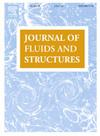Study on the high-speed shallow-angle water entry of cylinders with varying densities
IF 3.5
2区 工程技术
Q1 ENGINEERING, MECHANICAL
引用次数: 0
Abstract
An investigation into the transient fluid-structure interactions during the high-speed (600 m/s) shallow-angle (8°) water entry of cylindrical projectiles with varying densities (2.7-16.1 g/cm³) is presented. The fundamental mechanisms governing cavity dynamics and projectile stability are revealed using three-dimensional computational fluid dynamics (CFD) simulations, which are validated by synchronized high-speed imaging. The key findings demonstrate that asymmetric wetting of the cylinder’s head during the early stage of water entry induces a critical head-down moment that governs subsequent hydrodynamic behavior. Three distinct fluid dynamic mechanisms are identified: 1) Delayed upper cavity formation accompanied by asymmetric cavity expansion; 2) Splash convergence producing distinct upward and downward jets, with the latter inducing localized cavity collapse upon impacting the wall; and 3) Pressure redistribution at the head end caused by variations in angle of attack, which generates restoring moments through asymmetric flow patterns. Density-dependent kinematic analysis reveals that within the same range of horizontal displacement, low-density cylinders (ρ≤4.1 g/cm³) undergo multiple tail slaps, whereas high-density cylinders (ρ≥7.2 g/cm³) achieve rotational stabilization through head-end restoring moments prior to tail slap initiation. Quantitative analysis shows that increasing the density from 2.7 to 16.1 g/cm³ reduces the maximum angular deflection by 89.43 % and the accumulated trajectory curvature by 42.83 %. These findings establish material density as the primary control parameter for ricochet prevention during shallow-angle water entry.
变密度圆柱高速浅角入水研究
研究了不同密度(2.7 ~ 16.1 g/cm³)圆柱形弹丸高速(600 m/s)浅角(8°)入水过程中的瞬态流固耦合。利用三维计算流体动力学(CFD)模拟揭示了控制空腔动力学和弹丸稳定性的基本机制,并通过同步高速成像对其进行了验证。关键发现表明,在水进入的早期阶段,水缸头部的不对称润湿导致了一个关键的头部下降时刻,该时刻控制着随后的水动力行为。确定了三种不同的流体动力学机制:1)上部空腔的延迟形成伴随着不对称的空腔扩张;2)飞溅辐合产生明显的向上和向下射流,向下射流在撞击壁面时引起局部空腔塌陷;3)攻角变化引起的头部压力重分布,通过不对称流型产生恢复力矩。与密度相关的运动学分析表明,在相同的水平位移范围内,低密度圆柱体(ρ≤4.1 g/cm³)经历多次尾扇,而高密度圆柱体(ρ≥7.2 g/cm³)通过尾扇开始前的头部恢复力矩实现旋转稳定。定量分析表明,将密度从2.7 g/cm³增加到16.1 g/cm³,最大角偏转减少89.43%,累计轨迹曲率减少42.83%。这些研究结果表明,材料密度是浅角进水过程中防止跳弹的主要控制参数。
本文章由计算机程序翻译,如有差异,请以英文原文为准。
求助全文
约1分钟内获得全文
求助全文
来源期刊

Journal of Fluids and Structures
工程技术-工程:机械
CiteScore
6.90
自引率
8.30%
发文量
173
审稿时长
65 days
期刊介绍:
The Journal of Fluids and Structures serves as a focal point and a forum for the exchange of ideas, for the many kinds of specialists and practitioners concerned with fluid–structure interactions and the dynamics of systems related thereto, in any field. One of its aims is to foster the cross–fertilization of ideas, methods and techniques in the various disciplines involved.
The journal publishes papers that present original and significant contributions on all aspects of the mechanical interactions between fluids and solids, regardless of scale.
 求助内容:
求助内容: 应助结果提醒方式:
应助结果提醒方式:


